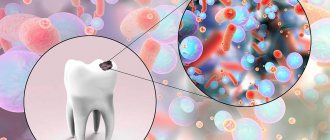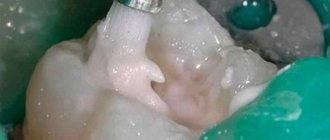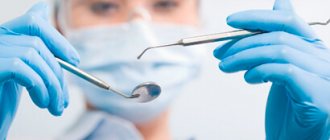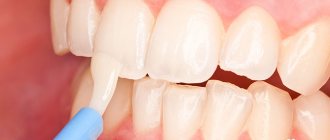Toothache during a cold: causes and treatment
One of the symptoms of a common cold, along with high fever, runny nose and cough, can be toothache. Teeth that are completely healthy at first glance can turn out to be a source of pain and signal problems with the body. When a toothache occurs due to a cold, adequate treatment prescribed by a general practitioner can quickly relieve you of this unpleasant symptom.
Why does toothache occur with a cold?
Toothache, along with headache and earache, can be a symptom of a cold. It occurs most often due to such a phenomenon as the occurrence of excess pressure in the nasal sinuses. When you have a cold, your sinuses become inflamed, and the mucus that forms in them blocks the passage, creating pressure that leads to pain. As soon as the inflammation of the mucous membrane is relieved, the teeth stop hurting. In addition, when we have a cold, we often drink a lot of liquids that contain acid. It can have a harmful effect on tooth enamel and cause pain. Also, when we have a runny nose, the mucous membrane of our mouth dries out quite noticeably, and the sugar that lingers on it in this way can also negatively affect the teeth.
Toothache due to a cold: treatment
So, we have looked at the main reasons why toothache most often occurs during a cold. Treatment prescribed by a therapist will help you recover as quickly as possible, and therefore get rid of painful sensations in your mouth. In the meantime, while the healing process is underway, you can relieve toothache using one of the proven home remedies.
- Rinsing with a baking soda solution (1 small spoon per glass of warm water) will help relieve inflammation and reduce irritation in the mouth. To achieve maximum effect, it is best to rinse your mouth 2-3 times an hour until signs of improvement appear.
- Dental drops. They can be purchased at any pharmacy for a small price. These drops have a calming effect and are based on camphor and valerian. It is enough to apply a few drops on a cotton swab and apply to the aching area.
- Sage decoction. Keep the warm sage decoction in your mouth for a few minutes, and you will notice that your toothache will become much less intense.
- Painkillers. If toothache causes you a lot of problems during a cold, then you can use any of the painkillers: ibuprofen, paracetamol, etc. The main thing is that the benefits of their use outweigh the harm they can cause to your liver and the entire body as a whole.
You can get a consultation at the DENTISTRY clinic. Make an appointment by calling +7 (8342) 308–088 or using the form below.
Make an appointment
The relationship between ENT organs and dental health
30.10.2017
Author: Dentist-periodontist Tamara Valerievna Kudzieva
Often, patients are faced with a situation where doctors have difficulty making a diagnosis due to the proximity of certain organs, and the patient is forced to turn to related specialists in order to avoid an inaccurate diagnosis.
Dental science is no exception. The diagnosis, etiology, i.e. is quite common. The cause of which dentists sometimes find it difficult to determine. Namely, inflammation of the maxillary (maxillary) sinus - sinusitis. Or a diagnosis whose name is more familiar - sinusitis. Patients are often confused about which doctor to see, a dentist or an ENT specialist.
Let's figure out why often an ENT doctor and a dentist cannot share this diagnosis.
First, let's give a definition and understand what the maxillary sinus is:
The maxillary sinus is a cavity formation in the upper jaw, lined with mucous membrane.
The function of the maxillary sinus is to warm and purify inhaled air. When an infection penetrates, one way or another, the mucous membrane of the sinus becomes inflamed, this process is called sinusitis (sinusitis). The patient usually complains of a feeling of nasal congestion, the presence of purulent exudate (discharged fluid), headaches, fever, pain in the projection of the sinus when tilting the head and palpation.
The reasons for the development of sinusitis can be odontogenic (due to the tooth) and non-odontogenic.
Non-odontogenic causes are most often associated with complications of colds or viral diseases, rhinitis. A specialist in ENT diseases works directly with this diagnosis.
We will dwell in more detail on the odontogenic cause of sinusitis:
As noted above, the cause of the development of this type of inflammation is an infected tooth.
This is due to the anatomical features of the structure of the upper jaw, since the roots of the teeth are located close to the sinus or even directly in it:
Thus, in the presence of a chronic inflammatory process in the canals of the teeth of the upper jaw, this infection spreads to the mucous membrane of the sinus, causing its inflammation. If there is an odontogenic cause for the development of sinusitis, it is not advisable to treat only the sinus by an ENT doctor, since this treatment will not give a long-term effect. It is necessary to eliminate the cause of inflammation - an infected tooth. And often, such unpleasant manipulations as punctures, rinsing, and prescribing antibacterial agents do not bring the desired result.
And therefore, competent ENT specialists, before starting treatment, must refer the patient to a dentist to exclude an odontogenic cause for the development of sinusitis.
If the inflammation is caused by a tooth, the dentist first needs to assess the feasibility of treating and preserving the tooth. If the prospect of treatment is assessed as favorable, then the endodontist performs high-quality root canal treatment to eliminate the infection. Before permanent filling of the canals, you may need to temporarily fill them with agents that have an antiseptic effect. And then, having seen the positive dynamics, seal the tooth hermetically. If the tooth is severely damaged, or there is no possibility of passage of the canals (sclerosis, severe curvature, root perforation, false passage, broken instrument), then such a tooth must be removed.
After eliminating the cause, after a couple of months, a control CT scan is performed to make sure that the sinus has begun to recover.
It is important to note that all sinuses communicate with each other; therefore, an infection from the maxillary sinus, in the absence of proper treatment, can spread throughout the entire sinus system, which greatly complicates treatment.
Thus, a competent approach to treatment and timely redirection to a suitable specialist will prevent an incorrect diagnosis and, as a result, incorrect treatment tactics. And therefore, save the patient’s time and finances.
Causes of toothache
As we have already said, the main reason for such painful sensations is the thinning of the enamel. Hyperesthesia can also develop due to:
- dentin reactions;
- allergies to dental medications;
- periodontal diseases;
- mechanical damage to enamel;
- hereditary predisposition.
Let's look at each cause of the problem in more detail.
High fever and toothache control
Most dentists agree that when the body temperature is elevated, it is not advisable to deal with dental problems. The body already has a difficult time - it is fighting the virus, trying to destroy pathogenic microflora. Additional intervention may negatively affect the speed of recovery. Moreover, with a cold, any wounds that arise after medical manipulations heal more slowly. Consequently, the risk of secondary infection increases sharply.
But the situation is completely different if the temperature is not a symptom of ARVI, but a consequence of tooth inflammation. Here, waiting for a runny nose or cough to go away is unacceptable. You should visit a doctor as soon as possible. Even a tiny dental root cyst can cause problems that lead to partial edentulism.
What to do if your teeth hurt due to coronavirus
When dental problems arise, they need to be solved immediately without waiting for external circumstances to change. If your tooth hurts badly due to Covid, or its crown part has collapsed, you need to go to the dentist. During a pandemic, the clinic uses all necessary measures to protect patients and doctors from the transmission of infection:
- daily check for ARVI symptoms;
- testing for coronavirus infection every 10 days;
- mandatory wearing of protective masks, gloves, goggles;
- regular disinfection of rooms, surfaces, door handles;
- use of bactericidal lamps in offices and waiting areas.
Wearing masks is mandatory for all patients (Decree of the Mayor of Moscow No. 92-UM dated September 25, 2020). If a patient refuses to wear a mask or have their temperature taken, the appointment will be cancelled.
Indications for dental treatment for colds
You can visit the dentist, but at the appointment, after an examination and history taking, the dentist will decide on the advisability of treatment in this situation. However, there are situations when seeing a doctor is mandatory:
- Cold symptoms such as headache, weakness, fever, and so on developed a few days after the onset of signs of dental disease or simultaneously with them. This may indicate that the condition that is mistaken for ARVI is actually a complication of pulpitis, a cyst on the root of a tooth, or another pathology of the oral cavity.
- Severe and constant pain in the tooth that does not calm down after taking painkillers, swelling of the gums around the painful tooth or on the corresponding side of the face. In such situations, treatment for the disease that is causing these symptoms may be necessary to prevent the infection from spreading throughout the body.
- Purulent discharge is observed from the gums near the diseased tooth, and the body temperature is greatly increased and does not decrease after taking antipyretics.
All of the listed conditions do not yet guarantee that treatment will be provided when visiting a dentist. The doctor may reschedule the appointment until complete recovery or begin the necessary manipulations if the benefits of treatment outweigh the possible risks.
What is absolutely forbidden to do?
In order not to double the painful sensations of aching in the jaw, it is important to adhere to several rules before visiting a doctor:
- Regularly clean the oral cavity of food debris; sometimes it is particles from lunches and dinners that often become the cause of especially severe pain in pulpitis and periodontitis.
- Never chew on the side of the affected tooth.
- Heating a sore spot is strictly prohibited. Any hot compresses increase blood flow and increase pain.
- Try not to be in a lying position; this position activates blood circulation in the periodontal tissues and increases pressure on them.
We have listed the main ways to relieve toothache. However, these methods, with all their diversity, will not help cure the cause of the unpleasant manifestation and are only a temporary measure. As soon as you feel your teeth hurting, make an appointment with the dentist. Believe me, the sooner you start treatment, the faster and cheaper you will get rid of painful sensations.
Is it possible to visit the dentist with a high temperature?
If a cold is accompanied by an increase in temperature, then all qualified dentists will say that it is impossible to treat teeth during this period. The appearance of a high temperature is a sign that the body is fighting the viruses that have infected it. During a cold, the body uses all its strength and capabilities, and additional intervention can only do harm. In addition, in this state, the healing process of any wounds that may arise during dental procedures can be greatly delayed, and, consequently, the possibility of getting new infections will increase. But the situation is completely different if the temperature is caused not by a cold, but by an inflammatory process in the oral cavity. Under such circumstances, seeking the help of a dentist is not only possible, but also necessary, and as soon as possible. After all, even a small cyst in the soft tissues of the oral cavity can lead to serious consequences.
Why can the periosteum of a tooth become inflamed?
The most common is odontogenic periostitis of the jaws, that is, an inflammatory process provoked by diseases of the teeth or periodontal tissues. Deep caries, pulpitis, periodontitis (inflammatory process at the apex of the tooth root), periodontitis - all these diseases, if not treated in time, lead to the appearance of gumboil. Also, one of the reasons for the development of the inflammatory process may be alveolitis - inflammation of the tooth socket, which in some cases occurs after tooth extraction. Inflammation of the periosteum after tooth extraction usually develops in those patients who do not rush to see a dentist when the first signs of complications appear in the postoperative period.
Much less common is toxic periostitis, caused by infection through the blood or lymph (usually due to some general infectious disease). The disease can also be caused by injuries to the jaw bone or surrounding soft tissue.
The relationship between nose and head pain
The nose is one of the sections of the respiratory system. It consists of several departments interconnected. If diseases occur on the visible part of the nose, they are easy to diagnose. However, nasal pain can be caused by damage to the internal parts that are located inside the skull. To understand why the nose hurts and radiates to the head, it is worth familiarizing yourself with its structure.
- The outer nose is the visible part. Its shape is formed by cartilage and several bones, as well as facial muscles. This is the first section into which the inhaled air penetrates, so it is initially purified from small particles and microorganisms.
- The nasal cavity is an expansion formed by bones and cartilage. Its posterior part narrows and passes into the nasopharynx.
- Paranasal sinuses (paranasal sinuses) are additional cavities that are located on opposite sides of the nasal cavity. There are anterior and posterior sinuses.
All parts of the nose are covered with mucous membrane. It is continuous, contains nerves and vessels, and connects to the epithelial layer of the oropharynx. The nasal mucosa has a distinctive feature - it contains olfactory receptors, with the help of which the nervous system is able to distinguish odors. In addition, it is the first barrier against viruses and bacteria that enter the body with inhaled air and can cause infectious diseases of the respiratory system.
Diseases that cause nasal congestion and discomfort reduce the supply of oxygen to the lower respiratory system. This causes insufficient nutrition of tissues, especially brain cells. Most colds are accompanied by a headache, which occurs due to respiratory failure. In addition, colds are accompanied by swelling of the mucous membrane, inflammatory processes, and increased formation of exudate.










